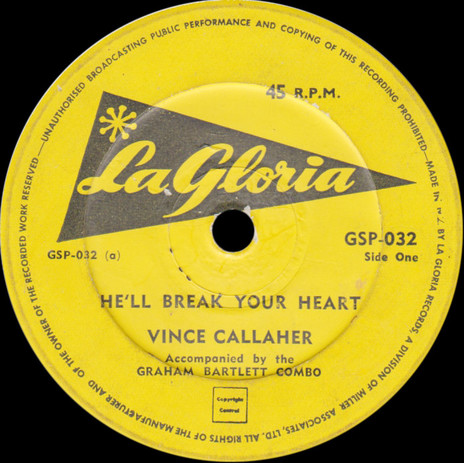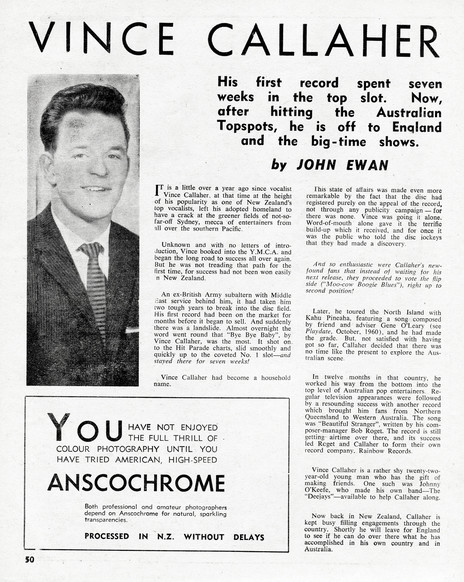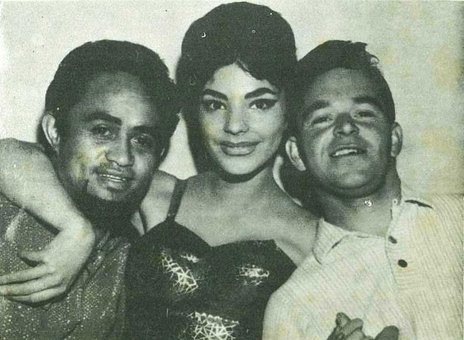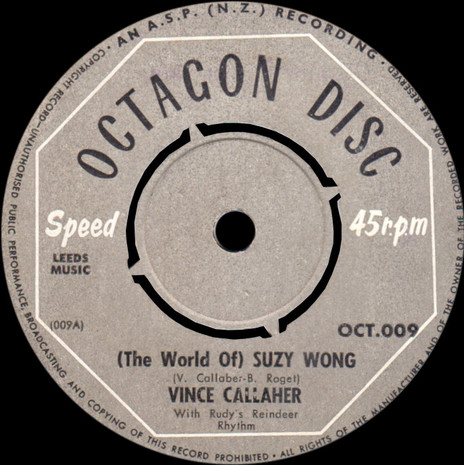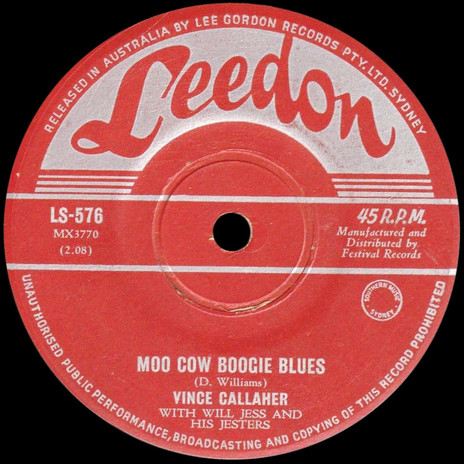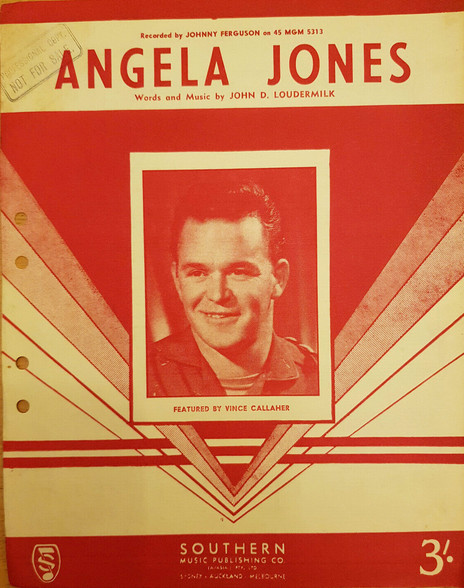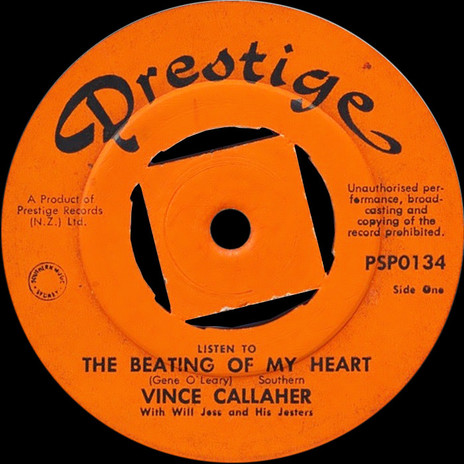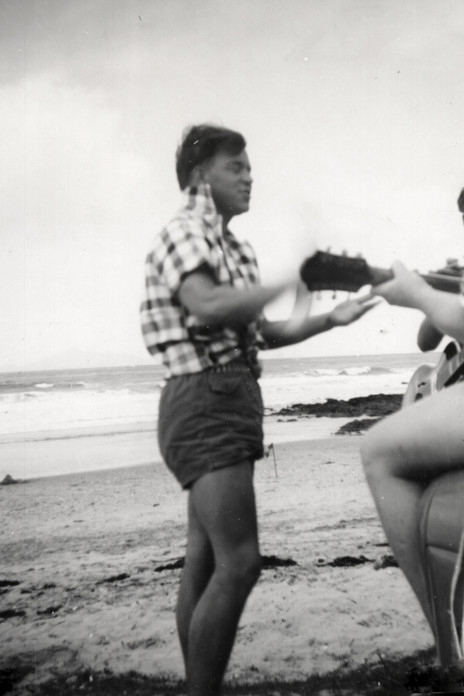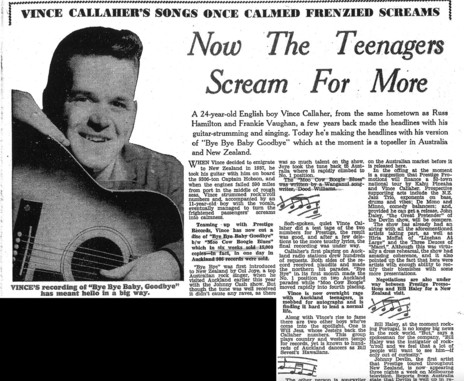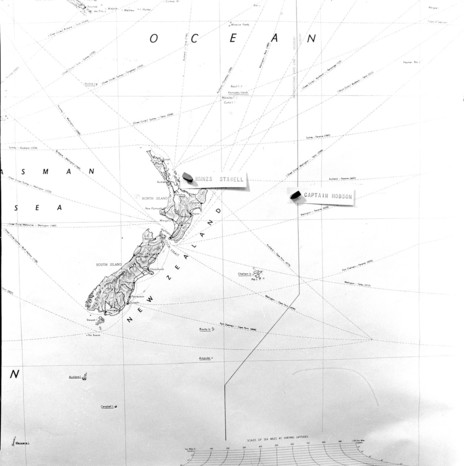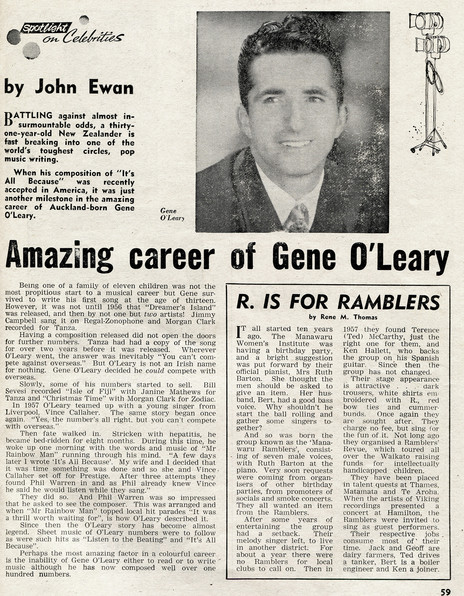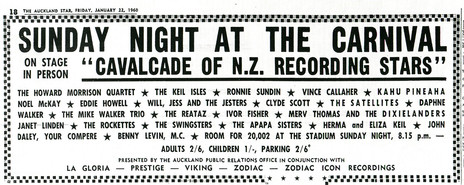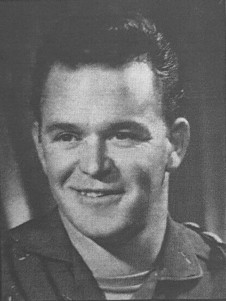With that spontaneous shipboard routine, Callaher’s music career was underway, but it stayed modest: seven recordings in New Zealand, a couple of which were also released in Australia. Callaher’s brief stint as a pop singer in New Zealand came in the hiatus between Elvis and the Beatles; what makes him different is that he sang original material, at a time when most New Zealand rock’n’roll bands played cover versions.
Before emigrating to New Zealand, Callaher had been a subaltern with the British Army, and his stint included a tour of duty in the Middle East. He was of the generation of young men in the UK who were still required to do national service: the beat groups of the 1960s had it lucky when the obligation was cancelled.
It took two years of hard work in Auckland before Callaher began to break into the music business. “Soft-spoken and quiet,” according to the Wellington entertainment weekly Joy, he performed with younger musicians such as Gray Bartlett and Bruce King.
He made demo recordings of ‘Bye Bye Baby Goodbye’ (by US writer Frank McNulty) and ‘Moo Cow Boogie Blues’ (by Whanganui writer Dood Williams). These caught the ears of promoter Phil Warren, who signed Callaher to his Prestige label. First out of the blocks on Prestige were studio recordings of the two demos, and backing Callaher was Will Jess and His Jesters, ie Bill Sevesi. In 1999 the latter explained: “That was the name Philip Warren decided to use because we used many names before so we decided to change one more time.”
Callaher’s first airplay on Auckland radio stations drew hundreds of requests.
Callaher’s first airplay on Auckland radio stations drew hundreds of requests. Warren wasn’t required to organise a publicity campaign, word of mouth did it for him. Playdate wrote later, “For once it was the public who told the disc jockeys that they had made a discovery.”
Both sides of the disc received plaudits and made the northern hit parades. Sevesi said that ‘Bye Bye Baby Goodbye’ entered the charts at No.2, ascended to No.1 the following week, staying there for five weeks. As there were no national charts in 1959, at best these would have been regional charts compiled by an Auckland record store or radio station. Sevesi remembered 1ZB announcer Phil Shone being supportive, and as the song’s charms waned, the disc was flipped to give airplay to ‘Moo Cow Boogie Blues’.
It was the first of seven singles released by Callaher between 1959 and 1960; four were on Prestige, two on La Gloria, and one on Octagon.
In 1959 Callaher met Gray Bartlett and Bruce King, who were in The Stereotones, a short-lived group which featured among its members Glyn Tucker on guitar and bassist Rick Laird (who later became a member of the Mahavishnu Orchestra). Through Bartlett’s friendship with local songwriter Gene O’Leary, the group backed Callaher on a few singles. They also embarked on a spontaneous Christmas tour of Northland dance halls, with Callaher as lead singer (Tucker and Mike Dolan also sang).
“There was no such thing as bookings,” King recalled in 2011. “We set off in convoy, and stopped at Ruakaka. The hall was on the left-hand side of the road, and the promoters of the tour hired the hall on the spot. We swept the hall out, slept on mattresses we borrowed from local farmers, and played at night – for a whole week, including New Year’s Eve.
“Mike Dolan sang ‘Mr Blues’, Glyn did the Elvis music – he was the hip-swinger – Vince’s repertoire was what we’d done on record, and ‘Teasable Pleasable You’, ‘Little Boy Sad’ – mostly ballad type things … There was no talk of money. I don’t think I got any. It was an adventure, playing music with a star. We were treated like stars by the public, not by the promoter. We thoroughly enjoyed ourselves.”
Callaher’s secret weapon was Gene O’Leary, a songwriter from Auckland and a pioneer in writing original material in the rock’n’roll era. Born in 1925, into a family of 11 children, O’Leary wrote his first song aged 35. ‘Dreamer’s Island’ was quickly covered by two artists – the Hulawai’ans for Regal Zonophone, Morgan Clarke for Zodiac – and Bill Sevesi recorded it in 2002.
Callaher’s secret weapon was Gene O’Leary, a pioneer in writing original material in the rock’n’roll era.
O’Leary managed to push back against the cultural cringe of the local record companies, who told him “You can’t compete against overseas.” But, wrote Playdate in 1960, “O’Leary is not an Irish name for nothing. Gene O’Leary decided he could compete with overseas. Bill Sevesi recorded O’Leary’s ‘Isle of Fiji’ with Janine Mathews, and Morgan Clarke released ‘Christmas Time’ for Zodiac.
Callaher and O’Leary had met in 1957, and fate rolled the dice in O’Leary’s direction. Bedridden with hepatitis for eight months, he woke up one morning and found the words and music of ‘Mr Rainbow Man’ had been running through his mind. A few days later he wrote ‘It’s All Because I Love You’, which Callaher recorded. He told Playdate in October 1960: “My wife and I decided that it was time something was done and so she and Vince Callaher set off to visit Phil Warren at Prestige.” After three attempts, Warren met them and gave the demos a hearing. As Callaher was already known to Warren, he got a good hearing, and Warren listened while he sang. Enthused Playdate: “Perhaps the most amazing factor in a colourful career is the inability of Gene O’Leary either to read or to write music, although he has now composed over 100 items.”
Other songs by O’Leary recorded by Callaher include ‘Listen to the Beating of My Heart’, ‘They’re Talking About Us’, and ‘Mr Rainbow Man’. ‘Silvery Moon’ (Prestige, 1961) had a B-side by Curtis Mayfield, ‘Don’t Ever Fall in Love’.
In 1960 Warren had big plans for Callaher: a 52-town national tour, double-billed with Kahu Pineaha. Also on the bill were the NZ Jazz Trio, comedian John Daley, and singer Hiria Moffatt.
According to Sevesi, it was after ‘Bye Bye Baby Goodbye’ that Callaher left New Zealand, and the Jesters were then hired to back teenage pop singer Ronnie Sundin. “Callaher decided there was no time like the present to explore the Australian scene.”
“IN 12 MONTHS CALLAHER WORKED HIS WAY INTO THE TOP LEVEL OF AUSTRALIAN POP ENTERTAINERS.” – PLAYDATE
Over the next year, Callaher knocked on the door of the Australian entertainment scene. According to Playdate, “In 12 months he worked his way from the bottom into the top level of Australian pop entertainers.” There were many television appearances, and ‘Beautiful Stranger’ was put on high rotate in Western Australia; written by Callaher and his manager Bob Roget, it was released in Australia on CBS Coronet. Its success led Roget and Callaher to form their own record company, Rainbow Records. (The pair also composed ‘[The World Of] Suzy Wong’, which was released on Octagon, with Callaher backed by Rudy’s Reindeer Rhythm.)
“Now back in New Zealand, Callaher is kept busy filling engagements through the country. Shortly he will leave for England to see if he can do over there what he has accomplished in his own country and in Australia.”But after a year Callaher returned to New Zealand. “Vince Callaher is a rather shy 22-year-old young man who has the gift of making friends,” wrote Playdate in April 1960. “One such was Johnny O’Keefe, who made his own band – the Deejays – available to help Callaher along.
But the young man whose arrival in New Zealand had been so dramatic, and his recording career so accomplished, if fleeting, left no trace after his return home to Britain in 1961.
